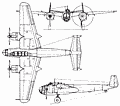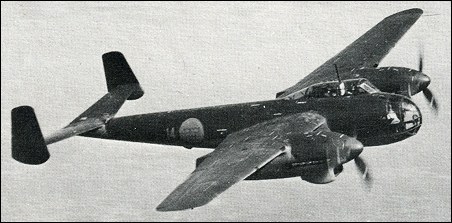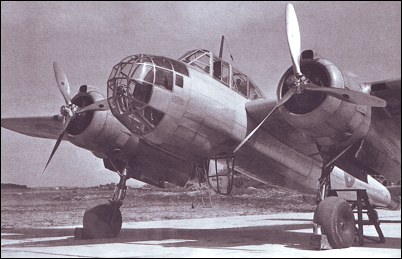|
| Designed in the late 1930s to meet an official Swedish requirement for a reconnaissance aircraft, the Saab-18 did not fly in prototype form until 19 June 1942. The delay was the result of changing requirements, the two Saab-18A prototypes being redesigned and equipped for the light bomber or dive-bomber role. A cantilever mid-wing monoplane, primarily of metal construction, the Saab-18 had retractable tailwheel landing gear, a twin-fin-and-rudder tail unit, and was powered as first flown by two 794kW Swedish-built Pratt & Whitney R-1830 Twin Wasp radial engines in wing-mounted nacelles. The crew comprised a pilot, navigator/gunner and bomb-aimer, the last having a position in the glazed nose of the fuselage. Early testing of the prototypes revealed that the Saab-18A was underpowered, but with no immediate remedy available the type was ordered into production in B18A bomber and S18A photo-reconnaissance versions, built to a combined total of 60 aircraft; late production examples of the S18A also carried radar equipment. The availability in 1944 of a Swedish licence-built version of the much more powerful Daimler-Benz DB 605B powerplant led to the single Saab-18B prototype, first flown on 10 June 1944 and followed by 120 B18B dive-bomber production aircraft. Final production version was the T18B (62 built) which had been developed to serve as a torpedo-bomber but was, instead, completed as an attack aircraft. With a crew of two, this had an armament of two 20mm cannon plus a 57mm Bofors gun mounted beneath the nose. The first of the B18A bombers began to enter service with the Flygvapen in June 1944 and production of the last T18B ended in 1948, these 242 production aircraft providing valuable service until the last of them was retired in 1956.

| MODEL | Saab-18B (B18B) |
| ENGINE | 2 x Daimler-Benz DB 605B, 1100kW |
| WEIGHTS |
| Take-off weight | 8800 kg | 19401 lb |
| DIMENSIONS |
| Wingspan | 17.0 m | 56 ft 9 in |
| Length | 13.23 m | 43 ft 5 in |
| Height | 4.35 m | 14 ft 3 in |
| Wing area | 43.75 m2 | 470.92 sq ft |
| PERFORMANCE |
| Max. speed | 575 km/h | 357 mph |
| Ceiling | 9800 m | 32150 ft |
| Range | 2600 km | 1616 miles |
| ARMAMENT | 1 x 7.9mm and 2 x 13.2mm machine-guns, 1500kg of bombs |
 | A three-view drawing of SAAB B.18A (800 x 707) |
| Ruben de Jong, e-mail, 10.09.2013 17:42 It looks indeed like a Dornier, and the Dornier was a good plane :-) reply |
| Johan Runfeldt, e-mail, 22.07.2011 18:19 The 57mm came in very late in the development of the Saab 18. It was only used in the T18B naval attack variant.
The cockpit was off-centre to allow the pilot to see the runway, and was a feature already on the first prototype, long before anyone suggested large-caliber gun armament. reply | | Rainer Nyberg, e-mail, 13.07.2011 14:20 The off-centre cockpit, was due to the fitment of the 57 mm gun alongside the crew. reply |
| Anthony Wilkins, 23.09.2010 20:54 This aircrat was clearly influenced by Dornier aircraft such as the Do.17 although the off-centre cockpit isunusual. t was repeated in the intruder variants of the Canberra reply |
|
Do you have any comments?
|
| 
COMPANY
PROFILE
All the World's Rotorcraft
|









 Rainer Nyberg
Rainer Nyberg
20
reply